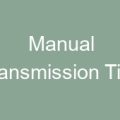Jumpstarting Your Car: A Step-by-Step Guide for Emergency Situations

In emergency, jumpstart car safely: 1. Park cars close 2. Connect jumper cables 3. Start working car 4. Try starting dead car 5. Detach cables 6. Drive.
In emergency situations, knowing how to Jumpstart Your Car can be crucial. Follow these step-by-step instructions to safely and effectively jumpstart your vehicle. First, park the cars close enough for the jump cables to reach. Next, connect the positive clamps to the batteries. Then, attach the negative clamps to a metal surface away from the battery. Start the working car and let it run for a few minutes. Finally, try starting your car that needed the jumpstart. If successful, drive it around to recharge the battery.
| Jumpstarting a car requires another vehicle with a charged battery. |
| Make sure both vehicles are in park before connecting cables. |
| Connect red cable to the positive terminals of both batteries. |
| Next, connect black cable to negative terminal of good battery. |
| Rev the engine of the working car to help charge the dead battery. |
- Check for any corrosion on battery terminals before jumpstarting.
- Keep ignition off when connecting cables to avoid sparks.
- Wait a few minutes after jumpstarting before starting the car.
- Drive the car for at least 20 minutes to recharge the battery.
- If car still won’t start, it may need a new battery or alternator.
How to Safely Jumpstart a Car in Emergency Situations?
Jumpstarting a car can be done safely by following proper procedures. Make sure to use proper equipment.
What are the Tools Needed to Jumpstart a Car?
Tools needed include jumper cables and a functioning car battery or jump starter pack.
When Should You Jumpstart a Car?
Jumpstart a car when the battery is dead, indicated by clicking sounds or failure to start.
Where is the Best Location to Jumpstart a Car?
Choose a safe location away from traffic, with enough space between cars for jumper cables.
Why is it Important to Connect the Jumper Cables in the Correct Order?
Connecting in the correct order prevents damage to electronics and ensures a safe jumpstart.
How to Identify the Positive and Negative Terminals on a Car Battery?
The positive terminal is usually red and marked with a plus sign, while the negative terminal is black.
What Precautions Should You Take Before Jumpstarting a Car?
Turn off both cars, check for any visible damage to the batteries or cables, and wear safety gloves.
How Long Should You Leave the Cars Connected During a Jumpstart?
Leave the cars connected for a few minutes to allow the dead battery to charge.
Can You Jumpstart a Car with a Completely Dead Battery?
It may be possible, but it is recommended to have a professional check the battery afterwards.
What Should You Do After Successfully Jumpstarting a Car?
Drive the car for at least 15 minutes to allow the battery to recharge fully.
Is it Safe to Jumpstart a Car in the Rain?
Avoid jumpstarting a car in the rain to prevent electrical hazards and potential accidents.
Can Jumpstarting a Car Cause Any Damage to the Vehicle?
Incorrect jumpstarting procedures can cause damage to the vehicle’s electrical system.
What are the Signs of a Failing Car Battery?
Signs include dimming headlights, slow engine cranking, and frequent need for jumpstarts.
How Often Should You Check the Condition of Your Car Battery?
Regularly check the condition of your car battery every few months or before long trips.
Why Should You Avoid Jumpstarting a Car with Incorrectly Connected Cables?
Incorrectly connected cables can cause sparks, damage to electronics, or even fire hazards.
Can You Jumpstart a Car Alone?
It is possible to jumpstart a car alone using a portable jump starter pack.
What Should You Do If Jumpstarting the Car Does Not Work?
If jumpstarting doesn’t work, the battery or starter may need professional inspection.




















